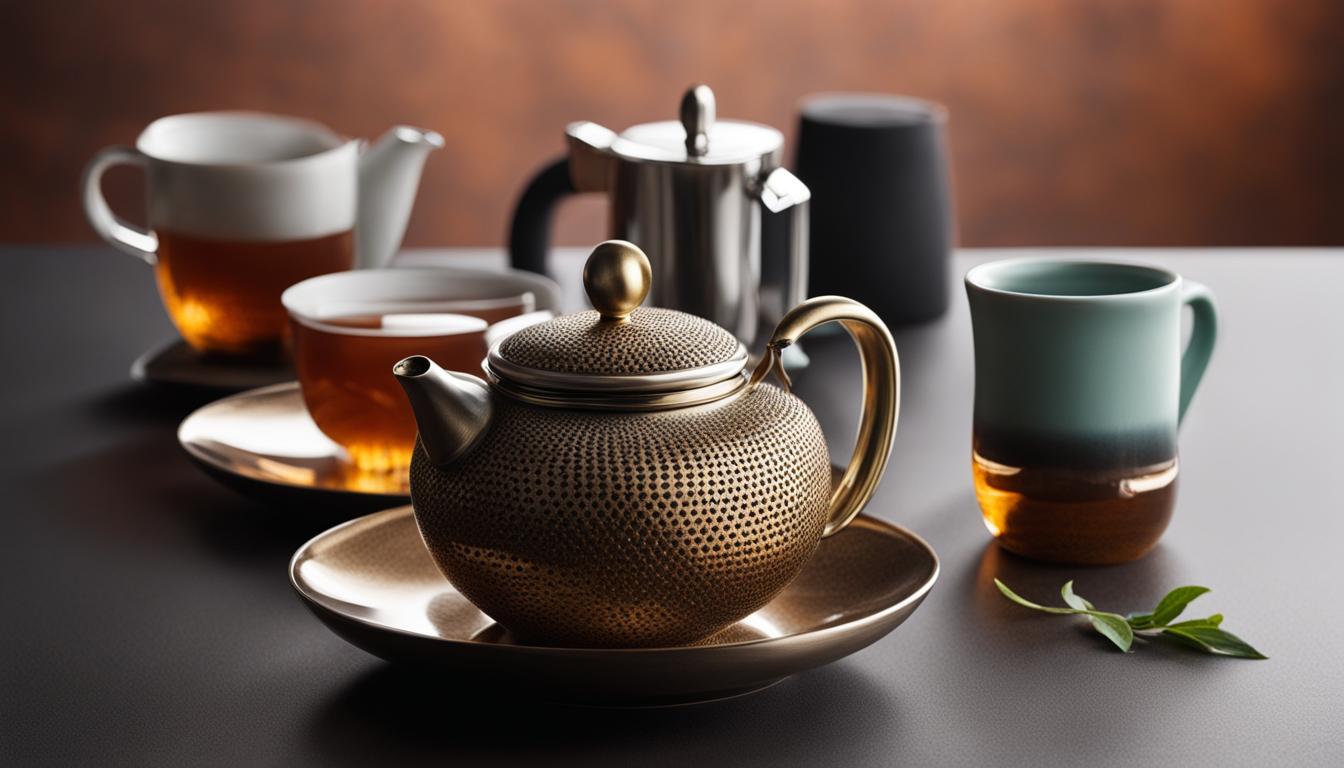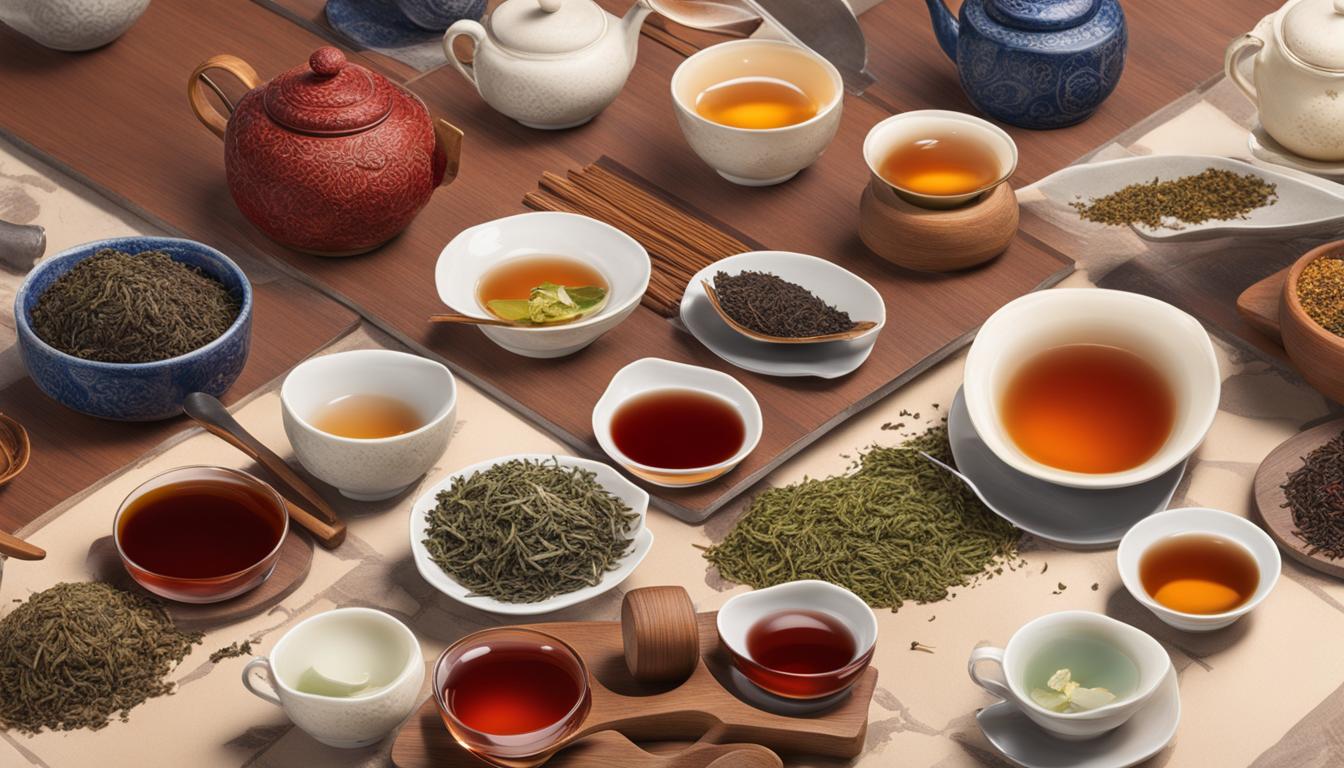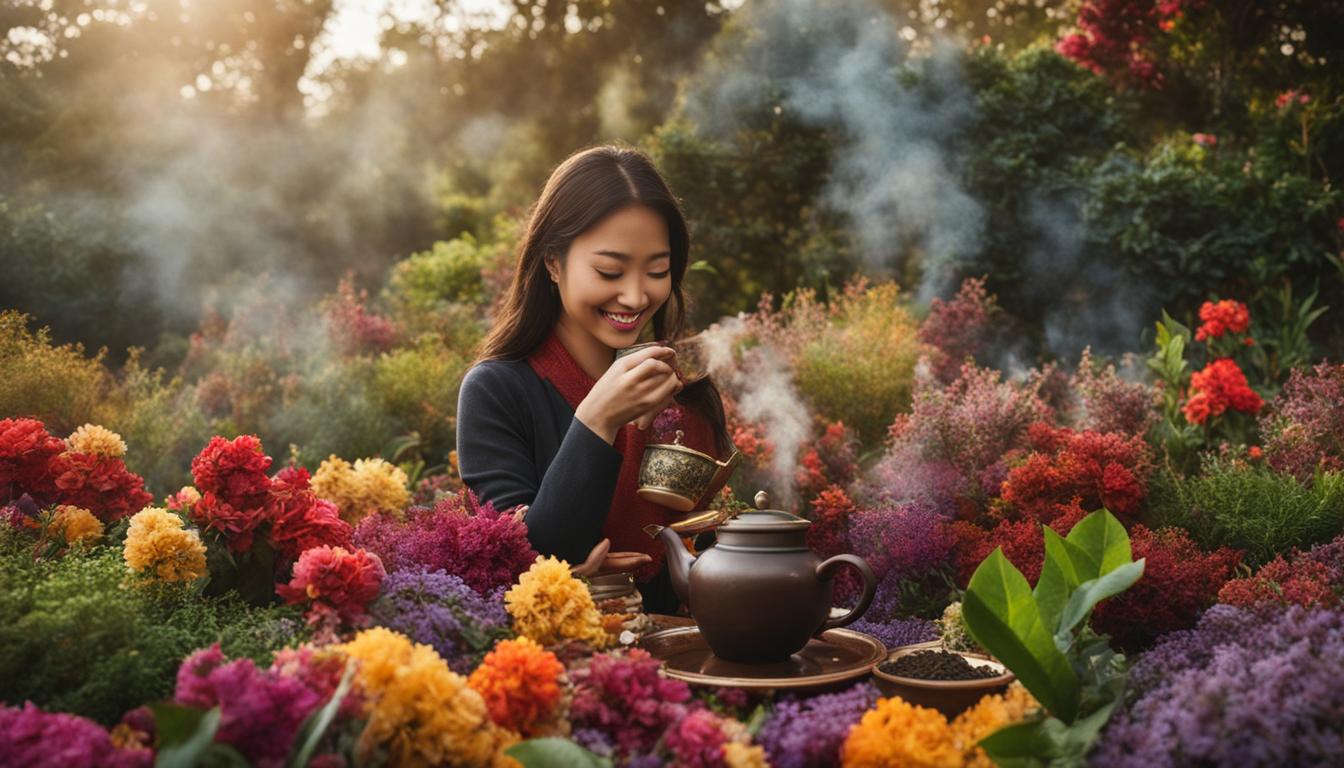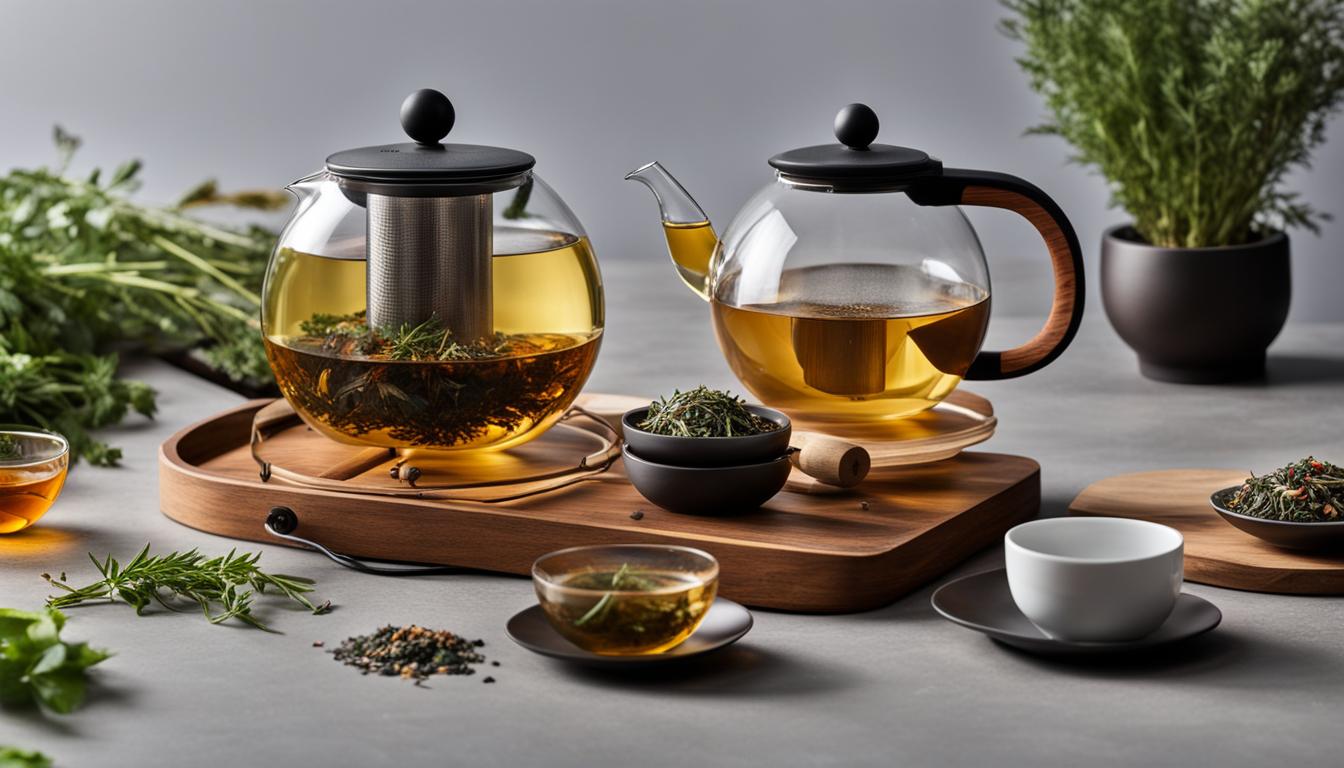When it comes to choosing the best materials for tea accessories, ceramic and stainless steel are two popular options. Ceramic teapots are often preferred for their aesthetic appeal and potential flavor contribution, while stainless steel teapots offer durability and a classic look. Let’s compare these materials in terms of durability, ease of maintenance, and taste influence to help you make an informed decision.
Key Takeaways:
- Ceramic teapots are known for their aesthetic appeal and potential flavor contribution.
- Stainless steel teapots offer durability and a classic look.
- Ceramic tea accessories can be fragile, but high-quality construction and glazing can make them durable.
- Stainless steel tea tools are easy to maintain and often dishwasher-safe.
- Ceramic teapots have the potential to influence the taste of tea, while stainless steel tea tools offer a neutral taste experience.
Durability of Ceramic Tea Accessories
When considering ceramic tea accessories, durability is an important factor to keep in mind. While ceramic teapots and cups are known for their delicate and elegant appearance, they can be more fragile compared to stainless steel. Ceramic teapots, in particular, have the potential to chip or crack if mishandled. However, it’s important to note that the durability of ceramic tea accessories greatly depends on their construction and quality.
Table: Quality Comparison of Ceramic Tea Accessories
| Factors | High-Quality Ceramic Tea Accessories | Lower-Quality Ceramic Tea Accessories |
|---|---|---|
| Construction | Made with strong, well-fired ceramics | May have weak or uneven construction |
| Glazing | Smooth and durable glazing | May have rough or thin glazing |
| Care | Require proper handling and maintenance | May be more prone to damage |
Choosing High-Quality Ceramic Tea Accessories
To ensure the durability of ceramic tea accessories, it’s essential to look for those made with high-quality construction and glazing. High-fired ceramics are stronger and less likely to chip or crack. Smooth and durable glazing adds an extra layer of protection to the teapot or cup, increasing its resistance to damage. Proper care, such as gentle handling and regular cleaning, also plays a significant role in maintaining the longevity of ceramic tea accessories.
“Investing in well-constructed ceramic tea accessories can enhance your tea drinking experience and ensure that your teapot or cup lasts for years to come.”
Ease of Maintenance for Stainless Steel Tea Tools
When it comes to tea accessories, stainless steel offers not only durability but also easy maintenance. Stainless steel tea tools are designed to withstand regular use and are known for their long-lasting performance. Unlike ceramic, stainless steel is a non-porous material that resists staining and retains its shine even after repeated use.
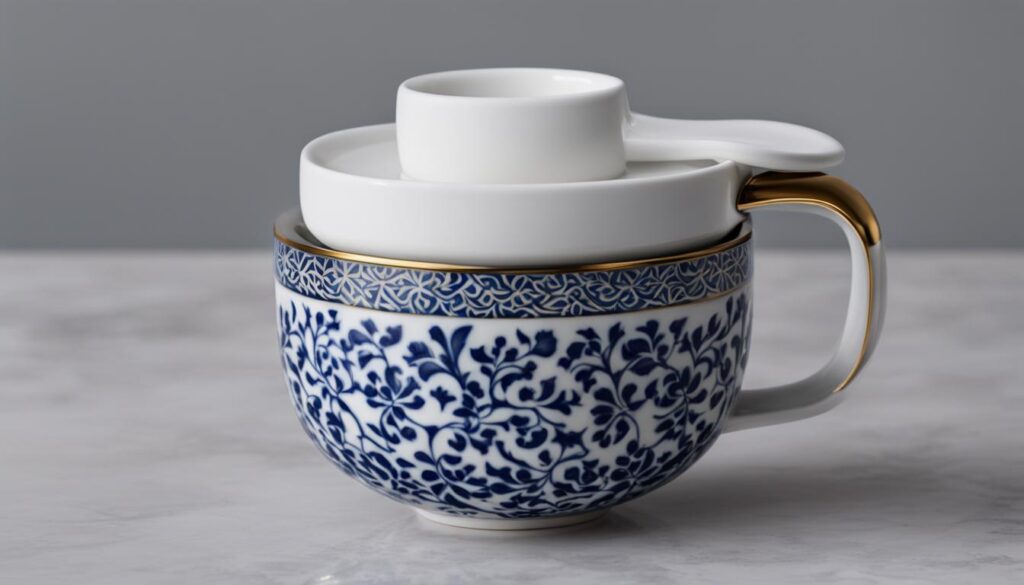
One of the key advantages of stainless steel tea tools is their heat resistance. Stainless steel can withstand high temperatures without warping or affecting the taste of the tea. This makes it an ideal choice for those who prefer to brew tea at higher temperatures or for longer steeping times. It also means that stainless steel tea tools can be used with confidence when preparing different types of tea, including black, green, oolong, and herbal teas.
Additionally, stainless steel tea tools are easy to clean and maintain. They can be safely washed in the dishwasher without worrying about damage or loss of shine. The non-porous surface of stainless steel prevents the absorption of flavors and odors, ensuring that each brew is fresh and free from any lingering tastes. This convenience and ease of maintenance make stainless steel tea tools a popular choice for tea enthusiasts looking for hassle-free brewing experiences.
Influence on Taste: Ceramic Tea Accessories
When it comes to choosing the best materials for tea accessories, ceramic is a popular option. But how does it influence the taste of your tea? Let’s explore the unique characteristics of ceramic tea accessories and their impact on the flavor profile of your brew.
Absorption and Flavor Retention
Ceramic teapots, especially those made from porous ceramics or left unglazed, have the potential to absorb flavors and aromas over time. This can lead to a subtle, yet noticeable, influence on the taste of your tea. The porous nature of the ceramic allows it to interact with the tea, enhancing certain flavors and infusing the beverage with its own subtle nuances.
“The porous nature of ceramic teapots allows them to absorb flavors over time, adding a unique touch to each brew.”
However, it’s important to note that glazed ceramic teapots, which have a protective coating, are less likely to affect the flavor of the tea. The glaze acts as a barrier, preventing the tea from directly interacting with the ceramic surface. This makes glazed ceramic teapots a more neutral option when it comes to taste influence.
Matching Ceramic Teapots with Tea Types
To make the most of the taste influence provided by ceramic tea accessories, it’s essential to match the teapot with the appropriate type of tea. For example, stoneware teapots are versatile and suitable for brewing various tea types. Porcelain teapots, on the other hand, are better suited for teas that require slightly cooler water temperatures, such as green or white tea.
When using ceramic teapots, it’s also crucial to properly care for them. Avoid using soap when cleaning, as it can seep into the porous surface and affect the flavor of your future brews. Instead, rinse with warm water and gently scrub with a soft brush or cloth. This will help maintain the integrity of the ceramic and preserve the unique taste experience it offers.
| Ceramic Tea Accessories | Taste Influence | Suitable Tea Types |
|---|---|---|
| Glass Teapots | Minimal taste influence | Floral, green, and light oolong teas |
| Stoneware Teapots | Subtle flavor enhancement | Various tea types |
| Porcelain Teapots | Neutral taste influence | Green or white tea |
| Unglazed Ceramic Teapots | Distinct flavor absorption | Darker oolongs and black tea |
Choosing ceramic tea accessories allows you to explore the fascinating world of taste influence in your tea brewing experience. Whether you prefer a subtle enhancement or a distinct absorption of flavors, ceramic teapots offer a wide range of options to suit your taste preferences and tea selection.
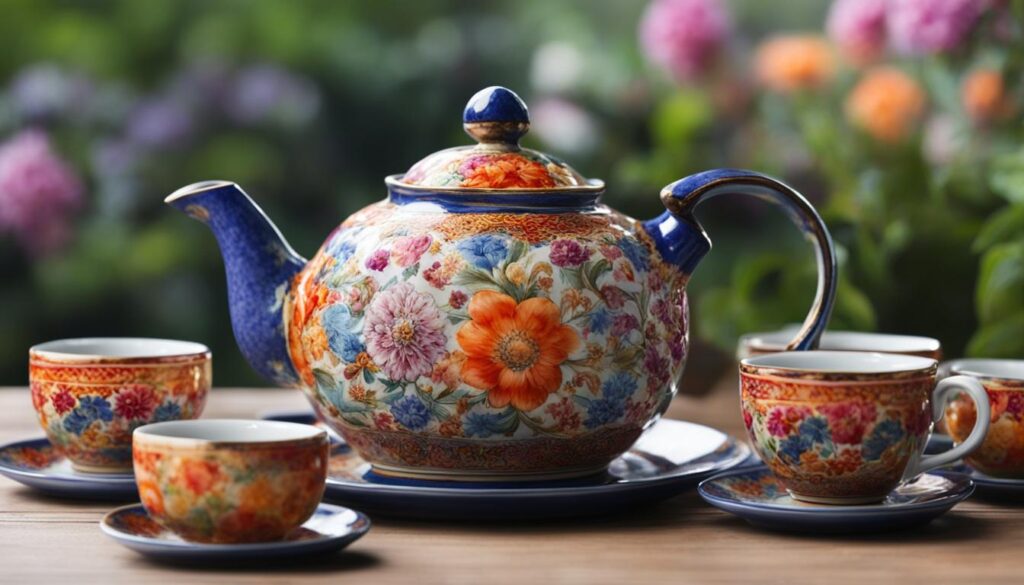
Influence on Taste: Stainless Steel Tea Tools
When it comes to the influence on taste, stainless steel tea tools offer a distinct advantage over ceramic ones. Unlike porous ceramic teapots, stainless steel does not absorb flavors or affect the taste of the tea. This makes stainless steel a popular choice for those who want a clean and pure tea taste.
Stainless steel teapots are especially well-suited for brewing teas that require higher water temperatures or longer steeping times, as the material does not alter the flavor profile of the tea. Whether you’re brewing a robust black tea or a delicate green tea, stainless steel tea tools provide a neutral vessel that allows the tea’s true flavors to shine.
With stainless steel tea tools, you can enjoy a consistent and unadulterated tea experience every time. The non-reactive nature of stainless steel ensures that no unwanted flavors or aromas are transferred to your tea, allowing you to fully appreciate the nuances and complexities of different tea varieties. So if you’re looking for a tea accessory that prioritizes the purity and integrity of your brew, stainless steel is the way to go.
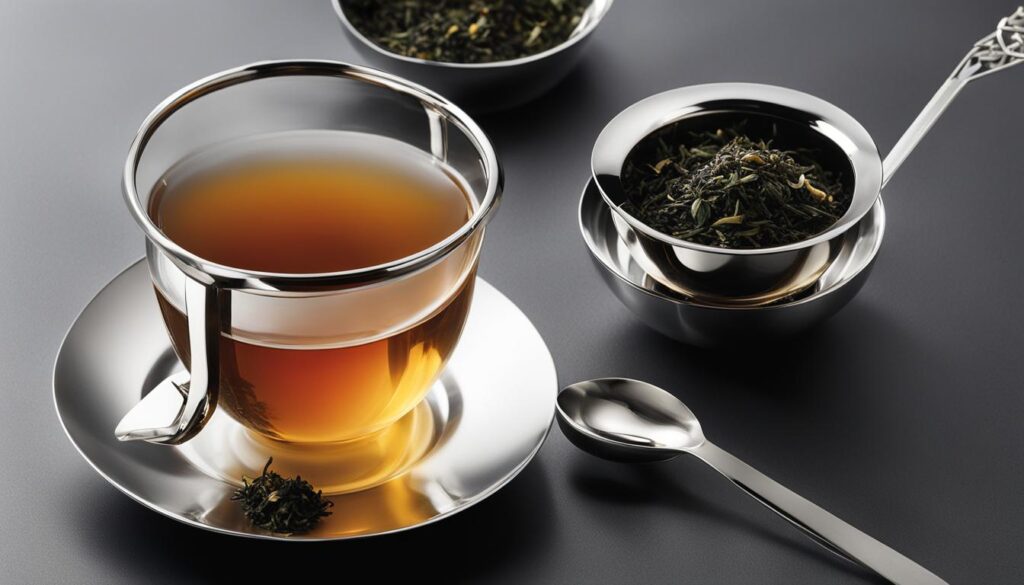
Table: Comparison of Ceramic vs. Metal Tea Sets
| Aspect | Ceramic Tea Accessories | Stainless Steel Tea Tools |
|---|---|---|
| Taste Influence | Potential to absorb flavors | Neutral taste |
| Durability | Fragile, but can be durable with quality construction | Highly durable and resistant to damage |
| Ease of Maintenance | May require delicate handling and specific care | Easy to clean and maintain; often dishwasher-safe |
| Aesthetic Appeal | Elegant and aesthetic | Classic and timeless |
As shown in the table above, while ceramic tea accessories offer potential flavor contribution and aesthetic appeal, stainless steel tea tools excel in terms of taste influence, durability, and ease of maintenance. Ultimately, the choice between ceramic and stainless steel comes down to personal preference and the specific qualities you value in your tea accessories.
Best Ceramic Tea Accessories
When it comes to ceramic tea accessories, there are various options to consider. Each type of ceramic tea accessory has its own unique qualities and features that cater to different brewing preferences and tea types. Here, we present a comprehensive guide to the best ceramic tea accessories that will enhance your tea brewing experience.
Stoneware Teapots
Stoneware teapots are versatile and durable, making them suitable for everyday use. They have excellent heat retention, ensuring that your tea stays hot for longer periods. Stoneware teapots come in various designs and sizes, allowing you to find one that suits your personal style. They are often dishwasher-safe, making cleanup a breeze after your tea time. Whether you’re brewing herbal infusions, black teas, or even blooming teas, stoneware teapots provide a reliable and stylish option.
Glass Teapots
If you enjoy the visual artistry of blooming teas or want to witness the beautiful colors of your tea infusions, glass teapots are the perfect choice. These teapots allow you to see the tea leaves unfurl and dance in the water, creating a mesmerizing brewing experience. Glass teapots are also ideal for brewing floral, green, and light oolong teas, as they showcase the delicate colors and unique characteristics of these teas. However, it’s important to note that not all glass teapots are dishwasher-safe, so be sure to check the care instructions before washing.
Porcelain Teapots
Porcelain teapots are renowned for their elegance and delicacy. They are often favored for teas that require slightly cooler water, such as green or white tea, as porcelain helps retain the optimal brewing temperature. The smooth and non-reactive surface of porcelain teapots ensures that there is no interference with the flavor of your tea. However, porcelain teapots usually require handwashing, so they may require a little extra care compared to other ceramic teapots. If you appreciate the beauty of fine porcelain and enjoy delicate teas, a porcelain teapot is an excellent addition to your tea collection.
Unglazed Ceramic Teapots
Unglazed ceramic teapots are often favored for darker oolong and black teas. The porous nature of unglazed ceramic allows the flavors and aromas of these robust teas to develop and deepen over time. However, unglazed ceramic teapots require special care and cannot be washed with soap or in the dishwasher. Instead, they should be rinsed with hot water after use to preserve the flavors. If you’re a fan of dark teas and appreciate the evolution of flavors, an unglazed ceramic teapot will enhance your brewing experience.
By considering these ceramic tea accessories, you can choose the best option that suits your brewing preferences and elevates your tea experience. Whether you go for the versatility of stoneware, the visual appeal of glass, the elegance of porcelain, or the flavor development of unglazed ceramics, the right ceramic tea accessories will enhance the flavors, aesthetics, and overall enjoyment of your tea.
Stainless Steel Tea Tools for Durability
When it comes to durability, stainless steel tea tools are unbeatable. Made from a robust material, these tea accessories are designed to withstand regular use without chipping, cracking, or staining. Whether you’re brewing tea for yourself or hosting a tea party, stainless steel teapots, strainers, and infusers are built to last.
Not only are stainless steel tea tools durable, but they are also easy to clean and maintain. The non-porous nature of stainless steel prevents it from absorbing flavors or staining, ensuring that your tea tools remain pristine even after multiple uses. Cleaning stainless steel tea accessories is a breeze, as they are often dishwasher-safe, saving you time and effort.
Choosing stainless steel tea tools means investing in long-lasting tea equipment that will continue to serve you for years to come. Whether you’re a tea aficionado or a casual tea drinker, stainless steel tea tools provide the perfect combination of durability, convenience, and style.
Table: Comparison of Ceramic and Stainless Steel Tea Accessories
| Ceramic Tea Accessories | Stainless Steel Tea Tools | |
|---|---|---|
| Durability | Can be fragile; subject to chipping or cracking if mishandled | Highly durable; resistant to chipping, cracking, and staining |
| Ease of Maintenance | May require delicate care; certain types cannot be washed in the dishwasher | Easy to clean and maintain; often dishwasher-safe |
| Influence on Taste | Porous ceramics can absorb flavors; glazed ceramics have minimal impact on taste | Neutral taste; does not affect the flavor of the tea |
As shown in the table above, stainless steel tea tools outperform ceramic tea accessories in terms of durability and ease of maintenance. While ceramic tea accessories may offer aesthetic appeal and potential flavor contribution, stainless steel tea tools provide a reliable and long-lasting solution for tea lovers.
Conclusion
So, after exploring the comparison between ceramic and stainless steel tea accessories, it’s clear that both materials have their own unique benefits. When it comes to choosing the best material for your tea set, it all boils down to personal preferences and specific needs.
If you value aesthetic appeal and the potential flavor contribution, ceramic tea accessories might be your cup of tea. They offer a delicate and elegant appearance that can enhance the overall tea-drinking experience. Just keep in mind that ceramic teapots require delicate handling to avoid chipping or cracking, and some ceramic materials may absorb flavors over time.
On the other hand, if durability, easy maintenance, and a neutral taste experience are more important to you, then stainless steel tea tools are the way to go. They are known for their robust construction, resistance to damage, and effortless cleaning. Stainless steel also ensures that the taste of your tea remains pure and unaffected, making it a great choice for those who want a clean and refreshing tea experience.
In the end, remember to consider factors such as your brewing preferences, the types of teas you enjoy, and your desired level of convenience and longevity when making your decision. Whether you choose ceramic or stainless steel, both materials offer their own advantages, and there’s no right or wrong choice.
FAQ
Are ceramic tea accessories durable?
Ceramic tea accessories can be durable if they are made with high-quality construction and glazing. However, ceramic is generally more fragile compared to stainless steel, so proper care is important to ensure longevity.
Are stainless steel tea tools easy to clean?
Yes, stainless steel tea tools are easy to clean and often dishwasher-safe. The non-porous material resists staining and retains its shine even after repeated use.
Do ceramic tea accessories affect the taste of the tea?
Ceramic tea accessories have the potential to influence the taste of tea, especially if they are porous or unglazed. However, glazed ceramic teapots are less likely to affect the flavor.
Do stainless steel tea tools affect the taste of the tea?
No, stainless steel tea tools do not absorb flavors or affect the taste of the tea. They provide a neutral taste experience, making them ideal for those who want a clean and pure tea flavor.
What types of teas are best brewed in ceramic teapots?
Stoneware teapots are versatile and suitable for various teas, while porcelain teapots are ideal for teas brewed with cooler water, such as green or white tea. Unglazed ceramic teapots are perfect for darker oolongs and black tea.
Are stainless steel tea tools durable?
Yes, stainless steel tea tools are known for their durability. They are less prone to chipping, cracking, or staining, making them ideal for long-term use.
How do I choose between ceramic and stainless steel tea accessories?
The choice between ceramic and stainless steel tea accessories ultimately comes down to personal preference and specific needs. Consider factors such as aesthetic appeal, potential flavor contribution, durability, ease of maintenance, and taste influence when making your decision.

